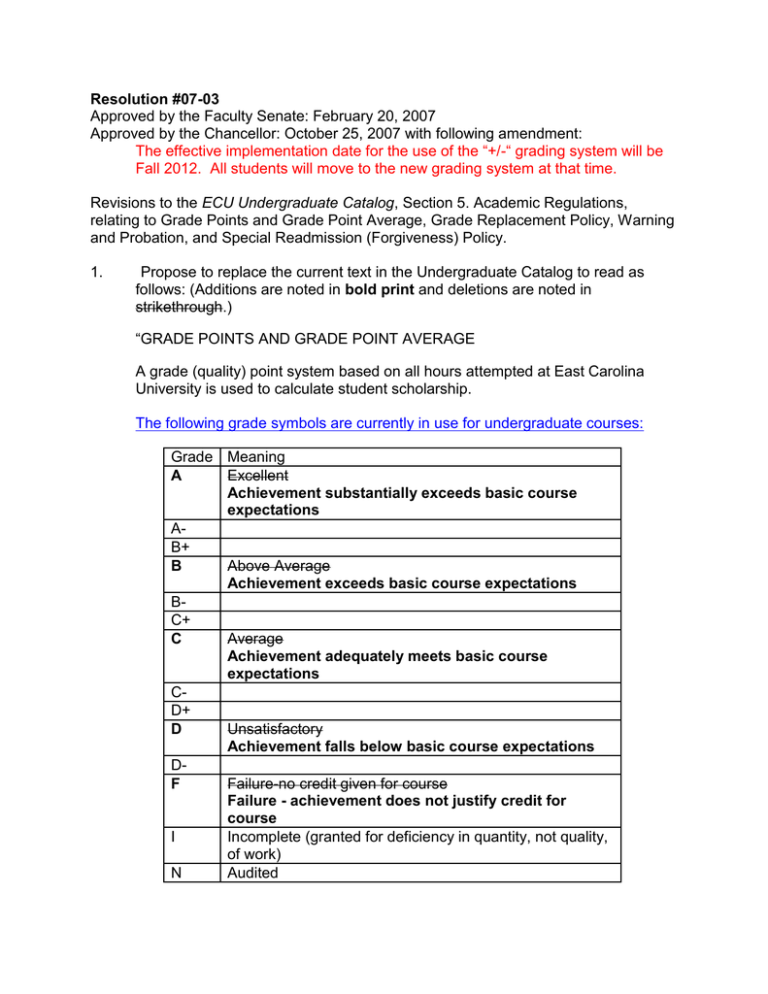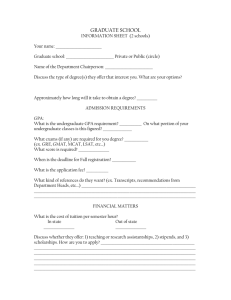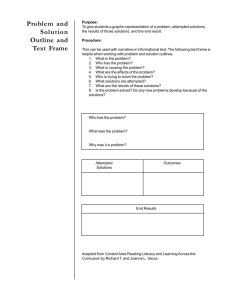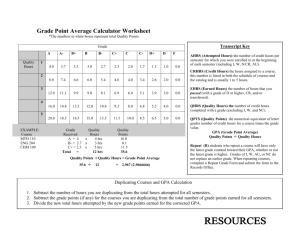grading system - East Carolina University
advertisement

Resolution #07-03 Approved by the Faculty Senate: February 20, 2007 Approved by the Chancellor: October 25, 2007 with following amendment: The effective implementation date for the use of the “+/-“ grading system will be Fall 2012. All students will move to the new grading system at that time. Revisions to the ECU Undergraduate Catalog, Section 5. Academic Regulations, relating to Grade Points and Grade Point Average, Grade Replacement Policy, Warning and Probation, and Special Readmission (Forgiveness) Policy. 1. Propose to replace the current text in the Undergraduate Catalog to read as follows: (Additions are noted in bold print and deletions are noted in strikethrough.) “GRADE POINTS AND GRADE POINT AVERAGE A grade (quality) point system based on all hours attempted at East Carolina University is used to calculate student scholarship. The following grade symbols are currently in use for undergraduate courses: Grade Meaning A Excellent Achievement substantially exceeds basic course expectations AB+ B Above Average Achievement exceeds basic course expectations BC+ C Average Achievement adequately meets basic course expectations CD+ D Unsatisfactory Achievement falls below basic course expectations DF Failure-no credit given for course Failure - achievement does not justify credit for course I Incomplete (granted for deficiency in quantity, not quality, of work) N Audited Grade points for a course are computed by multiplying the number of semester-hour credits by the numerical values assigned to the letter grade received. Numerical values for letter grades are as follows: Letter Grade Numerical Value A AB+ B BC+ C CD+ D DF 4.0 3.7 3.3 3.0 2.7 2.3 2.0 1.7 1.3 1.0 0.7 0* *Although no grade points are given for a grade of F, the hours attempted are recorded for each attempt of a given course. (See Grade Replacement Policy, below.) The GPA is then obtained by dividing the total number of grade points earned by the total number of semester hour credits hours attempted.” The following grade symbols are currently in use for all undergraduate courses: A-excellent, B-good, C-average, D-barely passed, F-failed (Course must be repeated to secure credit.), I-incomplete, N-audited. A grade of I is given for a deficiency in quantity, not quality, of work. Grade points are computed by multiplying the number of semester-hour credits by four for courses in which a grade of A is earned, by three for a grade of B, by two for a grade of C, by one for a grade of D. No grade points are given for a grade of F, but hours attempted are recorded for each attempt of a given course. (See Grade Replacement Policy, below.) The GPA is obtained by dividing the total number of grade points earned by the total number of semester hours attempted. 2. Propose to replace the current text in the Undergraduate Catalog to read as follows: (Additions are noted in bold print and deletions are noted in strikethrough.) “GRADE REPLACEMENT POLICY A student is permitted to use the Grade Replacement Policy a maximum of three times for courses below 3000 in which he or she has earned a grade of C-, D+, D, D-, or F. For example, a student may replace a grade in three different courses or may replace a single course grade a maximum of three times or a combination thereof not to exceed the limits of the policy. Approval to use the policy will not be given if a student wishes to repeat a course after he or she has successfully completed an advanced course covering the same or similar material, for example, a course in the same academic discipline for which the repeated course is a prerequisite. To replace a grade, the student should request a grade replacement on the grade replacement form, register for the course during the registration period, and submit the form to the Office of the Registrar. For the student to implement the policy, the form should be submitted no later than the last day of classes of the semester in which the student retakes the course. Although the original grade will not be used in determining the GPA of the student, the original grade will remain on the student’s permanent academic record and will be included in the calculation for consideration for honors. The replacement grade, or last grade, stands. Students receiving an F on the replacement grade must repeat the course if credit is required for graduation. In the event that the original grade was a D+, D, or D-, no additional credit hours will be awarded. In the event that the original grade was a D, no additional credit hours will be awarded.” 3. Propose to replace the current text in the Undergraduate Catalog to read as follows:(Addition is noted in bold print and deletion is noted in strikethrough.) “WARNING AND PROBATION A student will be placed on academic warning if his or her cumulative GPA is less than 2.0 2.00 but meets the minimum GPA required for his or her retention period. A student will be placed on academic probation if he or she does not meet the current academic eligibility standards. Students on probation are required to meet with their advisor and attend an academic review session conducted by the Academic Advising and Support Center or his or her academic unit prior to registration for the next academic term (fall or spring). A student will remain on academic warning or probation until the required GPA is obtained or the student is suspended.” 4. Propose to replace the current text in the Undergraduate Catalog to read as follows:(Addition is noted in bold print and deletion is noted in strikethrough.) “Special Readmission (Forgiveness) Policy East Carolina University students who have been out of school for a minimum of three consecutive academic years (six semesters, summer sessions excluded) may request special readmission. Such requests must be submitted in writing according to application deadline dates as specified above. Students who have been enrolled at another college or university since their last enrollment at East Carolina University must submit to the Office of Admissions official transcripts indicating that a minimum cumulative C average (2.0 on a 4.0 scale) has been earned in all transferable courses attempted. No transfer credit will be awarded for courses taken at any institution of higher education during the initial three consecutive academic years. For courses taken in subsequent years, only those in which the student received a grade of C or better will be accepted for transfer credit at ECU. The sole exception is that students may attend ECU during summer sessions for credit. Subsequent GPAs of students readmitted under this policy will be computed without inclusion of previous course work in which a grade below C C- was received; credit toward graduation will not be allowed for such course work. However, this work will be included in calculations for consideration for degrees with distinction. A student may be readmitted under the Forgiveness Policy only one time. Those readmitted under this policy are on academic probation for the first 19 s.h. of attempted course work. At the end of the term in which the nineteenth semester hour is attempted, a minimum cumulative C average must have been earned at East Carolina University on all course work attempted since readmission under forgiveness. Failure to meet this stipulation will result in the student’s being ineligible, except for summer school, until such time as the C average is obtained.”




